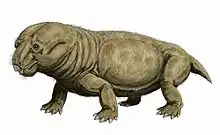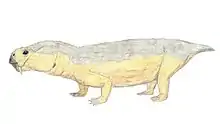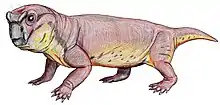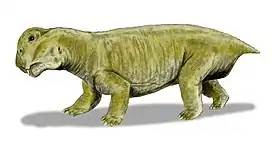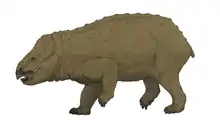Kembawacela
Kembawacela ("iron digger") is an extinct genus of cistecephalid dicynodont from the Late Permian Madumabisa Mudstone Formation of Zambia. It contains the type and only species, Kembawacela kitchingi. Like other cistecephalids, Kembawacela was specialised for a fossorial, burrowing lifestyle similar to modern day moles. It is unique amongst cistecephalids for the presence of a pair of tusks in the upper jaw, characteristic of many other dicynodonts but lost in other cistecephalids. It is likely that Kembawacela was a locally endemic species of cistecephalid in the Luangwa Basin of Zambia.
| Kembawacela | |
|---|---|
| Scientific classification | |
| Kingdom: | Animalia |
| Phylum: | Chordata |
| Clade: | Therapsida |
| Clade: | †Dicynodontia |
| Family: | †Cistecephalidae |
| Genus: | †Kembawacela Angielczyk, Benoit & Rubidge 2019 |
| Species: | †K. kitchingi |
| Binomial name | |
| †Kembawacela kitchingi Angielczyk, Benoit & Rubidge, 2019 | |
Description
Kembawacela broadly resembled other cistecephalids in size and shape. It was a small dicynodont (skull length roughly 5 centimetres (2.0 in) long along the base) and had a highly specialised body plan for digging. Kembawacela is known from skulls, lower jaws and various pieces of postcrania, including parts of the pelvis, femur, ulna and various vertebrae.[1]
Its skull is typical for cistecephalids, with a broad head and large temporal fenestra with a very short, tapered snout. It had large, strongly forward facing eyes like some other cistecephalids (including Cistecephalus), but unlike the smaller, sideways facing eyes of Cistecephaloides and Kawingasaurus. Similarly, the zygomatic arches project out almost laterally behind the eyes and curve back almost 90 degrees to the back of the skull. The pineal foramen ("third eye") is positioned very far back on the roof of the skull, overhanging the very back of the skull (similar to Sauroscaptor).[2] Kembawacela is most obviously distinguished by the prominent tusks in its upper jaw. The majority of Kembawacela specimens have these tusks, and it is possible that they were sexually dimorphic in this species. These tusks face slightly out to the sides, but do not sit out on a prominent caniniform process projecting from the jaw margin like in some other dicynodonts. Aside from the tusks, Kembawacela was otherwise toothless, and possessed a keratinous beak at the tips of its jaws, as is typical of dicynodonts. The beak was relatively broad and blunt, and the tip of the upper jaw was arched upwards.[1]
The body of Kembawacela is poorly known, but resembles that of other cistecephalids like Cistecephalus. It had three sacral vertebrae and an ilium with well developed forward and backward pointing processes, and a large, robust ulna in the arm. Unlike Cistecephalus, however, the head of the femur is roughly triangular shaped.[1]
History of discovery
Specimens of Kembawacela were first discovered and collected in the 1960s by Alan Drysdall and James Kitching in the Luangwa Basin of Zambia. They reported discovering at least 13 specimens that they preliminarily assigned to Cistecephalus microrhinus and the now synonymous C. planiceps. Four of these specimens were identified in the collections of the Evolutionary Studies Institute at the University of the Witwatersrand in Johannesburg, South Africa, although a possible fifth specimen originally noted by Kitching has since been lost.[1]
The specimens were later suggested to belong to a new species of Cistcephalus in an unpublished BSc honours thesis by Freeman in 1993. Further examinations and the discovery of an additional four specimens proposed that the Luangwa cistecephalid was an entirely new genus.[3] In 2019, the taxon was formally described in detail and named Kembawacela kitchingi by Kenneth Angielczyk, Julien Benoit and Bruce Rubidge. The genus name is from the phrase "kemba wacela", translated to "iron digger" in the locally spoken Bemba language. It was named for the iron-rich hematite nodules various specimens from the Luangwa Basin—including the type specimen of Kembawacela (NHCC LB18)—have been found in, as well referring to the proposed digging lifestyle of cistecephalids. The species was named to honour James Kitching, who collected the first specimens of Kembawacela.[1]
The specimens were collected from various different localities in the Luangwa Basin, but were all from the upper Madumabisa Mudstone Formation. This formation is believed to overlap in time with the Cistecephalus Assemblage Zone (AZ) and Daptocephalus AZ of the Karoo Basin in South Africa, which have been dated to the Wuchiapingian to early Changhsingian in the Late Permian. The specimens are housed at both the Evolutionary Studies Institute in South Africa and at the National Heritage Conservation Commission in Lusaka, Zambia.[1]
Classification
Kembawacela is well supported as a member of the family Cistecephalidae in the phylogenetic analysis of Angielczyk et al. (2019), where it was found as a relatively basal member of the clade:
| Kistecephalia |
| ||||||||||||||||||||||||||||||||||||||||||||||||||||||
Kembawacela is primarily distinguished from other cistecephalids by its tusks, but can also be uniquely diagnosed by a trough on the underside of the vomer and an interparietal bone with paired extensions that reach up from the back of the skull to flank the pineal foramen. There are also various other slight differences of the skull and skeleton between it and other cistecephalids.[1]
Palaeobiology
It is possible that Kembawacela was sexually dimorphic, as two of the seven known specimens appear to have lacked tusks. Notably, one of these specimens is the largest known individual, implying that the lack of tusks was not due to it not being fully grown yet. Sexual dimorphism is known from other cistecephalids, such as the prominent ridges over the eyes in Cistecephalus, and although Kembawacela lacks those traits the presence or absence of tusks is suggested to be an indicator of sexual dimorphism more broadly in dicynodonts. Unfortunately, the relatively small sample size means this possibility cannot be statistically analysed.[1]
The tusks of Kembawacela are also notable as one specimen preserves unerupted tusks within the jaw bones. There is no evidence that these tusks are replacements of a previous pair (as has been suggested to occur in Diictodon), and another specimen with the inside of the jaw exposed preserves no such replacements either. The size of the specimen is comparable to the others, which would suggest that the tusks of Kembawacela may not have erupted until quite late in the animal's life, close to their mature body size. It's possible that this relatively late eruption of the tusks in Kembawacela was taken even further in other cistecephalids, where their development was suppressed and prevented entirely from erupting in the tuskless species.[1][3]
Burrowing
Kembawacela shares various features with other cistecephalids associated with a fossorial (burrowing) lifestyle. The ulna, the only known bone from the forelimb, has the typically large olecranon process associated with scratch-digging found in other cistecephalids.
The skull has various features associated with burrowing, being broad and wedge-shaped. The large, forward facing eyes may be related to seeing in low-light environments, with binocular vision providing greater light sensitivity, although this is not typical of modern fossil mammals which have small eyes (as in Cistecephaloides and Kawingasaurus). Interestingly, Kembawacela is the only known cistecephalid known to preserve pieces of the bony sclerotic ring surrounding the eye, and they are remarkably smaller than would suggested by the size of the orbits. However, they were too incompletely preserved to estimate the light sensitivity of the eyes.
The footplates of the bony stapes are large, associated with hearing low-frequency sounds underground, although its inner-ear is not as specialised as Kawingasaurus.[1]
Palaeoecology
Kembawacela coexisted with a wide variety and abundance of other dicynodonts in the upper Madumabisa Mudstone Formation, including Endothiodon, Compsodon, Pristerodon, the burrowing Diictodon feliceps, Emydops, Dicynodontoides, a species similar to Katumbia, Odontocyclops whaitsi, Oudenodon bainii, Kitchinganomodon, Daptocephalus, Syops, Digalodon cf. rubidgei and a species of lystrosaurid.[3][4] Other therapsids included the locally endemic predatory therocephalians Ichibengops and Mupashi, as well as the more widespread Theriognathus microps and Ictidosuchoides longiceps, along with the semi-aquatic cynodont Procynosuchus and an indeterminate biarmosuchian.[5][6][7][8] Reptiles are represented by the pareiasaur Pareiasuchus, a herbivorous parareptile.[9]
Much of the fauna of the Madumabisa Mudstone Formation is shared with that of the Cistecephalus AZ in the Karoo, South Africa, suggesting the two regions shared similar biomes and were broadly connected. However, the presence of endemic species like Kembawacela are indicative of fine scale variations between the two localities, such as environmental differences. The fossorial lifestyle of Kembawacela and other cistecephalids is a likely factor in its endemism, as its unique ecology would have limited its ability to disperse and so restricted its range to within the Luangwa Basin.[1]
The environment of the upper Madumabisa Mudstone Formation was a wet, vegetated floodplain within a wide rift valley with plentiful sinuous meandering rivers, ponds and lakes prone to episodic flooding.[3]
References
- Angielczyk, K.D.; Benoit, J.; Rubidge, B.S. (2019). "A new tusked cistecephalid dicynodont (Therapsida, Anomodontia) from the upper Permian upper Madumabisa Mudstone Formation, Luangwa Basin, Zambia". Papers in Palaeontology. Online edition. doi:10.1002/spp2.1285.
- Kammerer, C.F.; Bandyopadhyay, S.; Ray, S. (2016). "A new taxon of cistecephalid dicynodont from the upper Permian Kundaram Formation of India". 2 (4): 569–584. doi:10.1002/spp2.1055. Cite journal requires
|journal=(help) - Angielczyk, K.D.; Steyer, J.‐S.; Sidor, C.A.; Smith, R.M.H.; Whatley, R.L.; Tolan, S. (2014). "Permian and Triassic dicynodont (Therapsida: Anomodontia) faunas of the Luangwa Basin, Zambia: taxonomic update and implications for dicynodont biogeography and biostratigraphy". In Kammerer, C.F.; Angielczyk, K.D.; Fröbisch, J. (eds.). Early evolutionary history of the Synapsida. Springer, Dordrecht. pp. 93–138 In. ISBN 978-94-007-6841-3.
- Kenneth D. Angielczyk (2019). "First occurrence of the dicynodont Digalodon (Therapsida, Anomodontia) from the Lopingian upper Madumabisa Mudstone Formation, Luangwa Basin, Zambia". Palaeontologia Africana. 53: 219–225. hdl:10539/26832.
- Huttenlocker, Adam K.; Sidor, Christian A.; Angielczyk, Kenneth D. (2015). "A new eutherocephalian (Therapsida, Therocephalia) from the upper Permian Madumabisa Mudstone Formation (Luangwa Basin) of Zambia". Journal of Vertebrate Paleontology. 35 (5): e969400. doi:10.1080/02724634.2015.969400.
- Huttenlocker, A. K.; Sidor, C. A. (2016). "The first karenitid (Therapsida, Therocephalia) from the upper Permian of Gondwana and the biogeography of Permo-Triassic therocephalians". Journal of Vertebrate Paleontology. 36 (4): e1111897. doi:10.1080/02724634.2016.1111897.
- Kemp, T. S. (1979). "The primitive cynodont Procynosuchus: functional anatomy of the skull and relationships". Philosophical Transactions of the Royal Society B. 285 (1005): 73–122. doi:10.1098/rstb.1979.0001.
- Sidor, C. (2015). "The first biarmosuchian from the upper Madumabisa Mudstone Formation (Luangwa Basin) of Zambia". Palaeontologia Africana. 49: 1–7. hdl:10539/17373. ISSN 2410-4418.
- Lee, M. S. Y.; Gow, C. E.; Kitching, J. W. (1997). "Anatomy and relationships of the pareiasaur Pareiasuchus nasicornis from the Upper Permian of Zambia" (PDF). Palaeontology. 40 (2): 307–335.

